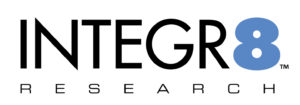Richard Sands, author and publisher of Alternative newsletter The Sands Report, featured Integr8 Research President Matt Bailey in the October 29 and November 5 editions. Matt covers strategy that applies to multiple contemporary formats, including Alternative, CHR, Hip Hop/R&B, and Country. The interviews are reprinted with permission.
Matt…tell me about yourself. Do you have a background in radio?
One night when I was three, my dad brought me home a black transistor radio. I tuned to 79/WQXI-Atlanta during AM Top 40’s last glory days. I was hooked. I’d later get the thrill of working with those same ‘QXI legends at Cox Radio Atlanta. So yeah, I’m a life-long radio geek!

Integr8 Research President Matt Bailey
What is Integr8 Research…and how long have you been there?
Integr8 Research helps stations pick the right new music. It’s all we do. I joined in 2009, when Coleman Insights acquired the old Core Call Out with the mission of transforming it for the 21st century. Three years later, we launched Integr8 New Music Research.
What’s your take on Shazam’s value for radio?
Shazam has tremendous value in helping radio detect which new songs spark listener intrigue. In a study we conducted in 2016, we found that 73% of songs that became Top 10 most Shazamed songs also went on to become Top 10 Hits on the Billboard Hot 100. For 33% of those songs, Shazam spotted the hits at least 3 weeks in advance. .
Is there a certain way that PDs should look at Shazam that would be most helpful?
Remember why someone Shazams a song: They’re hearing a song that 1) someone else played and 2) they want to know the artist or title. If a song or its singer is easily recognizable, listeners don’t need to Shazam it.
So that’s why Shazam doesn’t predict many mainstream Pop songs?
Yes. You already recognize Taylor Swift. If listeners stream a song, they won’t Shazam it, because either they already knew the artist title, or that info is already on their screen. That’s why Hip Hop streaming hits don’t get Shazamed. Finally, when you see a song’s Shazams dropping, it doesn’t mean listeners don’t like the song anymore. It usually means they’re now familiar with it. With those caveats, the #1 place listeners hear songs they Shazam is on the radio.

Shazam can be a great tool for radio programmers, but it must be used correctly.
There’s more than just Shazam. What about streaming metrics – can radio programmers confidently use these numbers to augment their programming decisions?
Absolutely! As with Shazam, it’s imperative to know what streaming tells you—and what it doesn’t: Streaming stats tell you the number of times a song played. It does not tell you how many different people streamed a song or how often each user streamed it. A song that 10 users stream 1 time is the same as a song 1 user streams 10 times. That’s how “Baby Shark” became a hit. (Thanks, toddlers). It’s like having AQH share, but not knowing your Cume or TSL.
What does your research show you on the subject of streaming?
In a Spotify deep-dive we conducted in 2019, we found listeners use Spotify much like they used Tower Records 25 years ago. When your favorite artist drops a new project, you rush to Spotify to sample it. At first, most of the tracks in the new album will dominate Spotify’s ton 10 most streamed songs. Over time, however, listeners settle on one or two songs that they want to hear repeatedly for weeks—and those songs are the ones that become radio hits. So when looking for hits on streaming, don’t simply look at what’s big this week: Look for songs that are big week after week.
What about Alternative in particular?
For Alternative, the biggest hits aren’t likely to dominate the most-streamed songs the way Hip Hop songs does, plus many tend to build over time just as they do in radio. When using streaming, look for songs that listeners consistently stream week after week. Those titles are your hits.

Richard Sands of The Sands Report
I see! Good advice. Anything else?
Streaming doesn’t tell you how many people hate a song—because if you hate a song, you simply don’t play it. In radio, haters matter—because they tune out.
What about digital sales? When I first started in San Francisco, sales helped determine what songs got added to the playlist!
It depends. In some formats such as Country, enough listeners still want to own music, so knowing which songs people pay to keep forever is valuable data. For other genres such as Hip Hop, streaming has already usurped sales. Alternative lies somewhere in the middle.
Are there any other metrics we should pay attention to?
MScore doesn’t get PR these days, but stations still use it and it has the opposite limitation of streaming: MScore may tell you which songs cause people to tune away from your station, but it tells you nothing about which songs listeners tuned in to hear in the first place. So use it, especially for highly familiar titles, but remember: Avoiding tune out is of no use unless you first generate tune in.

How can programmers best using streaming?
Use streaming to see what new songs are culturally relevant that might not be on your radar as well as which songs in your format listeners keep steadily playing week after week—but streaming won’t tell you if a song has haters.
Next, Shazam?
Use Shazam to see which of the new releases you’re playing sparking interest among your listeners are—but don’t use it as a substitute for overall popularity for songs listeners know.
And callout?
Use callout to see a complete picture of each songs’ familiarity, appeal, and relevance among those listeners that most impact your ratings—just remember callout can’t tell you the future of a song your listener’s barely know.
Did I forget any?
Here’s a strange one for Alternative stations looking to break Indie artists: Wikipedia. If a seemingly unknown act has an extensive Wikipedia page, it shows they have a passionate fan base.
For those new to programming…what is callout research?
Callout helps stations pick the right currents by finding a station’s target listeners in their specific market, playing them the six-second “hook” of songs the PD chooses, and having listeners rate those songs. A callout report shows which songs listeners know, love and hate, so programmers know which songs should be in power, secondary, or recurrent rotation. Stations typically receive callout weekly or bi-weekly, so they can stay on top of fast-moving new music trends.
Is it difficult to find respondents? I understand fewer and fewer people want to answer their phones and participate.
That’s where “callout” is really an outdated term: The days of randomly calling people at home and asking them to stop what they’re doing and rate music on the phone are long gone. For Integr8 New Music Research, we use three different ways to find listeners—by calling landlines (fewer each year), calling mobile phones (expensive, but needed for a representative sample) and online. Then—regardless of how we find a listener—all respondents evaluate a station’s music online. Listeners have several days to take the survey whenever they have time and it’s optimized to be easy on a smartphone.

From a station standpoint, what is needed? Do stations still have to put together a tape of hooks to play to the respondents?
The days of preparing a tape have fortunately gone the way of the cart machine. Today, stations simply edit and send each hook as a digital audio file, or hire a hook vendor to do it for them. The most important elements really are carefully considering 1) which listeners are most important to your ratings success before you begin conducing new music research, and 2) which songs you test with an ear towards your station’s strategy. As Jon Coleman says, “every song is a marketing decision.” If you think your listeners might love a song, but you also think that song isn’t what listeners want from your station, for crying out loud don’t test it!
Is callout still the gold standard for figuring out rotations and recurrents?
The obvious advantage of customized new music research (a.k.a. callout) is that it focuses on people who actually live in your market and listen to your station. Streaming and Shazam data may drill down on your town, but can’t zone in on people who actually tune in. Beyond that advantage, Callout is the only tool that shows 1) both the positive and negative reaction to your music. 2) if listeners are passionate about or merely accepting of it, 3) how different camps within your audience respond to your music, and 4) where each song is in its lifecycle as a hit—which helps you know when it’s time to move a song to recurrent (Integr8 has a proprietary tool called Hitcycle that makes that decision clear.) No other tool is as comprehensive as callout.
What do you say to companies worried about budgeting for this kind of research?
How much revenue would your station lose if your AQH share slipped just 1% from playing the wrong currents? How much is customized new music research for your station? When you compare those two numbers, can you really afford not to have it?
Thanks for joining us, Matt! Any final thoughts?
Radio’s best listeners are people who love great radio. They enjoy the shared experience of your personality who loves the music as much as they do. They love your sarcastic afternoon jock who always can relate to their crappy day. They feel they’ve finally found their tribe when they tune in. Great radio takes real relationships—and real relationships require real people on the air playing the music you’ve painstakingly researched. Tools and technology change. Friendship doesn’t.
